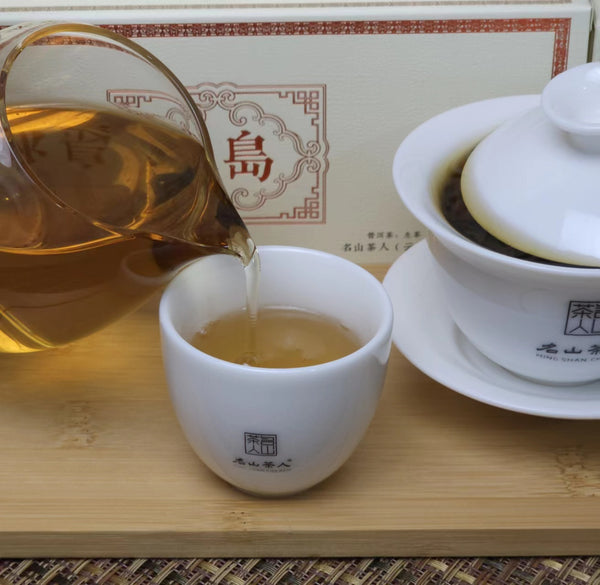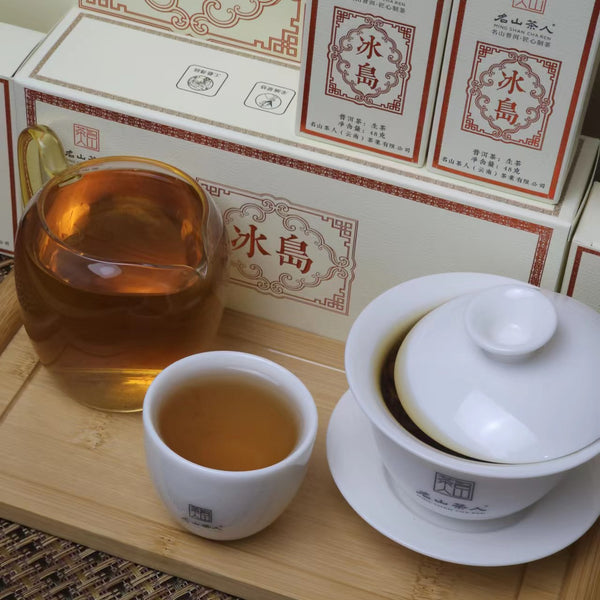Chin Yunnan Pu-erh Tea Icelandic raw tea – Zen Tea Master (zentea-shop.com)
The place of origin is Iceland Village, Menghu Town, Shuangjiang County, Lincang City, Yunnan Province, Iceland has five cottages, respectively, Iceland old cottage, the boundary, the south force, Nuowu, dam crooked. General Iceland Puerh tea refers to Iceland old village. Iceland belongs to the large-leafed tea, the leaf type is fat and large, and the color of tea green is generally brownish-black. Tea aroma is very soft, with icing sugar sweet icing sugar rhyme, and tea broth with each other, hanging cup fragrance lasting without publicity. The soup color is golden and bright. After the entrance to the sweetness of the mouth quickly, the bitter sweet mouth feeling is also one of the reasons why people are obsessed with drinking tea, Icelandic tea has the same very good sweetness. Excellent bubble resistance, even bubble more than 20 bubbles, still soup color golden, mellow flavor. The leaf bottom is thick, complete and soft with vitality. Effects: Cleanses the intestinal tract, has the effect of lowering fat, refreshing and lowering blood pressure. Suitable for: meat lovers, overweight people, etc.

1. Origin of the name Iceland
Iceland is a famous tea production area in Shuangjiang County, Lincang City, and the origin of Iceland's name is related to the Dai ethnic group. Mengku, Lincang City, Yunnan Province, has a famous Bonma Snow Mountain, 3200 meters above sea level, with year-round snow at the top of the mountain, the mountain is surrounded by clouds and mist, the primitive forests are densely covered, and large-leafed species of ancient tea trees are all over it. Halfway up the northern section of the Bonma Mountain Range, there is an ancient Dai village called "Iceland", Dai "Bian Island" or "Bian Island", meaning the place where bamboo plaques and fences are used as the gate of the village.
2、Iceland Five Cottages
Iceland has a long history of tea production, which, according to historical records, began with the tribute tea of Dai Tusi in 1485 of Ming Chenghua, and since then has created the everlasting Puerh legend.
Iceland is in the northernmost part of Menghu Township, 33 kilometers away from Menghu Township and bordering on Nami Township of Lincang City. Iceland Village Committee under the jurisdiction of the five village groups, respectively, Iceland, South Press, Dam crooked, Nuowu, the boundary, five cottages close to each other, tea characteristics are similar, but only Icelandic natural village of tea can be truly meaningful called Icelandic tea.
3、Iceland Ancient Tree Tea Plantation
Icelandic village is located at an altitude of 1750 meters in the native old village, can be said to have the best conditions of sunshine, rain, moisture, such a geographical location ecological environment, creating a charming charm of Icelandic tea.
According to survey statistics, Icelandic tea from today's maximum age of about 500 years or so, of which Icelandic old walled village more than 100 years of ancient trees 4954, the annual spring tea production of no more than 3 tons, 500 years of ancient trees in the village less than 200, the annual spring tea production of only a few hundred kilograms, the demand exceeds the supply.
Icelandic tea is China's first recognized national species in 1984, the natural growth of the tree height of up to 4-30 meters, is a typical Menghu large-leaf arbor tree tea, leaf fat and soft, tea fragrance. One bud and two leaves of spring tea contain 1.7% amino acids, 33.8% tea polyphenols, 4.1% caffeine, and 18.2% total catechins, so it is strong in astringency, strong and sweet, and is a superior variety for processing Puerh tea.
4, Icelandic tea taste characteristics
Icelandic tea taste presents two main characteristics:
(1) The flavor is inclined to be sweet and refreshing. Sweet performance in the soup sweet, sweet flavor, fresh, cool, which is mainly in the soup sweet and fresh.
(2) Icelandic tea tea soup aroma is high. Tea aroma has honey, orchid, icing sugar aroma, which is dominated by icing sugar aroma, the most persistent.
Characteristics of Icelandic tea that manifests itself in the mouth:
With low bitterness and astringency in the mouth, the first two brews may feel bland, but it is in this progression that the richness of the tea gradually unfolds. After the tea is swallowed, the tea flavor will slowly spread out unknowingly, piling up into a very rich, sweet and refreshing tea flavor. Gradually there is a cool air in the throat area, slowly transformed into the middle and back of the tongue, double sip of tasty, almost no tea flavor is detected at the time of entry, the tea flavor is gradually extended from the throat to the entire mouth.
After three or four infusions, the throat area has a cool sweetness, sweetness swirling with the cool sweetness of the rock candy, sweetness and shengjin obvious and long-lasting, unique rock candy rhyme, aftertaste, is recognized by the tea industry, the degree of coordination of the tea is extremely high.
5. The origins of "icing sugar sweetness" and "coldness"
When you taste a good quality Puerh raw tea with the right craftsmanship, you will easily feel a sense of coolness and sweetness.
This is because tea generally contains hydrolyzed tannins. When hydrolyzed tannins are decomposed in your mouth, on the one hand, they will produce glucose, which makes you feel sweet, and this is the sweetness; on the other hand, hydrolyzed tannins will absorb heat during the decomposition process, which makes you feel cool.
When the content of hydrolyzed tannins in a certain tea is high enough, the cooling sensation will be obvious. When the aftertaste is presented, it makes you feel like this is like eating icing sugar. And as the icing sugar melts in the mouth, it also absorbs heat, so the taste of icing sugar is a combination of coolness and sweetness.

Icelandic tea reputation is not only a false head support, but also has a great correlation with the taste. If there is no hard taste indicators to conquer the masses of tea drinkers, there will be no wave after wave of competition. But as a beverage, the pursuit of the top extreme also caused the high price of Icelandic tea, many tea drinkers can only be deterred, until it becomes a legend .....

